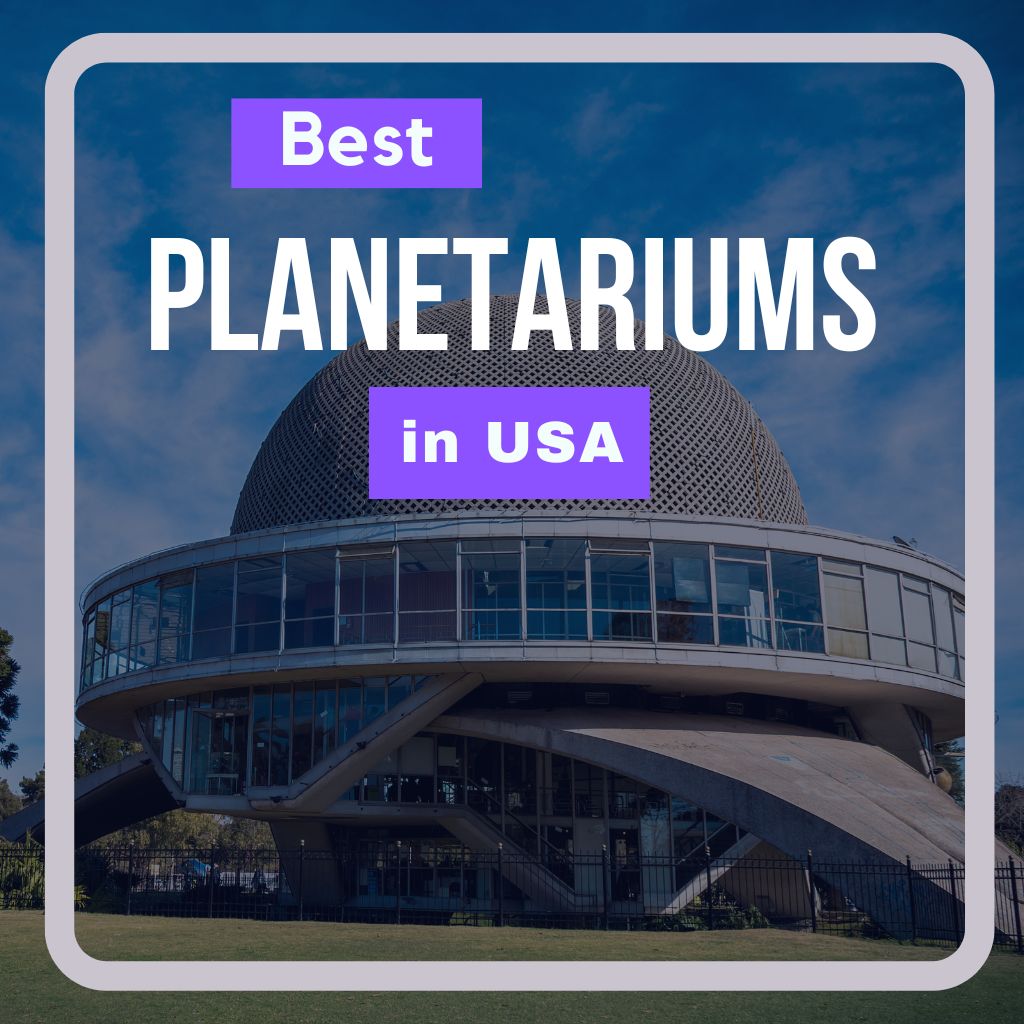This site contains affiliate links to products. I may receive a commission for purchases made through these links.
A planetarium is a place designed to show you the night sky right from the heart of your own city. Imagine being able to see stars, planets, and galaxies up close without needing a powerful telescope or a clear night. That’s exactly what a planetarium offers.
In this article, we will list and rank the best planetariums in the USA. So, if you’re a space enthusiast or just curious about the stars above, keep reading about the top planetariums to visit.
1. Alexander Brest Planetarium, Jacksonville
Located in the Museum of Science and History in Jacksonville, Florida, the Alexander Brest Planetarium offers an immersive and educational astronomy experience.
The facility boasts a 60-foot dome with a state-of-the-art projector that can display a realistic night sky filled with thousands of stars. It hosts a variety of shows focusing on different astronomical phenomena and events, making it an ideal place for both novice stargazers and seasoned astronomers.
2. Morrison Planetarium, San Francisco
Morrison Planetarium in San Francisco, California, is part of the California Academy of Sciences and is one of the largest and most advanced digital domes in the world. It offers highly immersive shows, using the latest technology to take visitors on a voyage through the universe.
It also hosts regular talks and presentations from leading scientists and astronomers, providing a great opportunity to learn about the latest discoveries in space exploration.
3. Burke Baker Planetarium, Houston
The Burke Baker Planetarium at the Houston Museum of Natural Science in Texas is a state-of-the-art facility known for its high-definition digital system. This planetarium allows visitors to explore everything from the local solar system to distant galaxies.
With shows ranging from exploring the night sky to uncovering the secrets of black holes, this planetarium caters to a broad range of interests and ages.
4. Gates Planetarium, Denver
Located at the Denver Museum of Nature & Science in Colorado, the Gates Planetarium provides a mesmerizing 360-degree experience.
Utilizing top-tier projection technology, the planetarium offers highly immersive shows, allowing you to traverse the solar system and journey to the edges of the known universe.
5. Mark Smith Planetarium, Macon
Situated at the Museum of Arts and Sciences in Macon, Georgia, the Mark Smith Planetarium offers a variety of educational and entertaining shows that captivate audiences of all ages.
From exploring the constellations to delving into the mysteries of our solar system, the planetarium uses its state-of-the-art star projector to make these cosmic journeys feel incredibly real.
6. Samuel Oschin Planetarium, Los Angeles
Perched atop the Hollywood Hills in Griffith Observatory, the Samuel Oschin Planetarium in Los Angeles is one of the most iconic planetariums in the country.
With a Zeiss star projector and a variety of immersive shows, this planetarium takes viewers on unforgettable journeys. Its location also offers stunning views of the city and the stars above.
7. Golden Pond Planetarium and Observatory, Kentucky
Located in the Land Between the Lakes National Recreation Area in Kentucky, the Golden Pond Planetarium and Observatory offers a unique stargazing experience.
The facility offers a variety of shows that take audiences on a guided tour of the night sky, highlighting constellations, planets, and other celestial phenomena. The adjacent observatory allows for real-time sky gazing through a modern telescope.
8. Adler Planetarium, Chicago
Chicago’s Adler Planetarium, located on the edge of Lake Michigan, is a historic institution – it was the first planetarium in the Western Hemisphere. It has three full-sized theaters, including the Grainger Sky Theater, which offers ultra-high-resolution shows.
The Adler Planetarium is also a hub for science education and outreach, providing a variety of programs to encourage the exploration of our universe.
9. Albert Einstein Planetarium, Washington D.C.
The Albert Einstein Planetarium, located inside the Smithsonian National Air and Space Museum in Washington D.C., offers high-resolution video and special effects displayed on an impressive dome.
Shows here cover a variety of space-related topics and often include actual data from space missions and current research, making it an exciting destination for both education and entertainment.
10. Charles Hayden Planetarium, Boston
The Charles Hayden Planetarium, nestled within Boston’s Museum of Science, stands as a pinnacle of modern technological advancements in the realm of digital theater.
The state-of-the-art Zeiss Starmaster optical star projector brilliantly brings the night sky to life on the 57-foot domed screen, accurately projecting over 9,100 individual stars. Coupled with its digital full-dome projection system, it generates immersive 3D shows that take viewers on a breathtaking journey through our galaxy and beyond.
The planetarium not only offers stellar visual experiences but also enriches the minds of its visitors with a plethora of topics ranging from the latest celestial discoveries to a guided tour of the current night sky.
11. Strasenburgh Planetarium, Rochester
Strasenburgh Planetarium, Rochester, is at the Rochester Museum & Science Center in New York. It is renowned as an epicenter for space science education.
This beloved institution houses a massive 65-foot dome, within which a high-tech star projector brilliantly maps out the cosmos in great detail. The planetarium’s live, interactive shows, narrated by astronomy experts, allow visitors to delve into celestial phenomena.
12. Arvin Gottlieb Planetarium, Kansas City
Located in the historic Union Station of Kansas City, the Arvin Gottlieb Planetarium is one of the largest and highest-resolution dome screens in the world.
Measuring 60 feet in diameter, the dome is coupled with an advanced digital system, providing ultra-sharp images and an immersive 3D experience. With a 10,000-watt surround sound system, it makes the journey through the cosmos a multisensory experience.
The planetarium regularly hosts diverse shows, from live sky tours guided by expert astronomers to breathtaking laser light performances, all aimed at nurturing a passion for space exploration in visitors of all ages.
If you want to nurture your passion for space exploration differently, besides going to a planetarium, you can start by getting a powerful telescope such as the Celestron CPC 1100. It is a great telescope with an 11-inch aperture, providing excellent light-gathering capabilities for clear and detailed views of celestial objects.
The Meade LX90 is another versatile telescope known for its exceptional optics and advanced features. With its reliable tracking system and GPS alignment, it offers convenient and precise navigation of the night sky.
The Celestron NexStar 8SE is a compact yet powerful telescope featuring an 8-inch aperture and a computerized GoTo mount.
13. Jennifer Chalsty Planetarium, Jersey City
Housed in the Liberty Science Center in Jersey City, New Jersey, the Jennifer Chalsty Planetarium is a marvel in itself. It claims the title of the largest planetarium in the Western Hemisphere.
Its immersive shows are projected in 8K resolution, offering viewers a visual treat filled with stunning detail and vibrant colors.
With a focus on astronomy education and cosmic visuals, visitors can explore the constellations, journey to the edges of the observable universe, and even traverse the landscapes of alien planets.
14. Fiske Planetarium, Boulder, Colorado
Fiske Planetarium and Science Center in Boulder, Colorado, offers a captivating and educational experience. The planetarium’s engaging shows provide a deeper understanding of astronomical phenomena and current discoveries.
Alongside its interesting shows, Fiske Planetarium also hosts interactive exhibits, workshops, and educational programs, making it a hub for scientific exploration and inspiration.
15. Bishop Planetarium, South Florida Museum, Bradenton
The Bishop Planetarium has firmly cemented its reputation as an iconic space science institution. The heart of this planetarium is its top-tier, all-digital projection system that fills a massive 50-foot dome with vivid, high-definition visuals, bringing the cosmos to life before the audience’s eyes.
Bishop Planetarium caters to a broad range of interests, thus demystifying the universe’s complexities for visitors of all ages.
16. Boyd E. Christenberry Planetarium, Birmingham, Alabama
Situated at Samford University in Birmingham, Alabama, the Boyd E. Christenberry Planetarium is an invaluable resource for university learners and the public.
Nestled under its 30-foot dome is the robust Spitz A3P star projector that meticulously charts the night sky, projecting a spectacle of constellations, stars, and celestial events.
The planetarium’s slate of programs is as diverse as it is educational, spanning the gamut from basic stargazing tips to deep dives into space science news, blurring the line between entertainment and education.
17. W. A. Gayle Planetarium, Montgomery, Alabama
A part of Troy University and located in Montgomery, Alabama, the W. A. Gayle Planetarium is lauded as one of the Southeast’s most impressive planetariums.
Its features include a 50-foot dome and an advanced Konica Minolta Super MediaGlobe II projection system that breathes life into the cosmic phenomena portrayed.
It accommodates a variety of interests, offering programs that delve into topics as varied as the life cycle of stars, the enigma of black holes, and the mythology behind constellations.
18. Dorrance Planetarium at the Arizona Science Center, Phoenix
Positioned within the Arizona Science Center in Phoenix, Dorrance Planetarium stands out as one of the country’s largest and most technologically advanced planetariums. Visitors are taken on a 360-degree voyage.
The planetarium’s diverse selection of shows merges cutting-edge visuals, captivating storytelling, and educational content, making for an unforgettable astronomy journey.
19. Holt Planetarium, Lawrence Hall of Science, Berkeley
Holt Planetarium invites visitors into an intimate, immersive cosmic exploration experience. With a firm commitment to distilling complex astronomical concepts into comprehensible narratives, the planetarium presents a variety of programs.
Its specialty lies in leveraging the latest discoveries and research in astronomy and translating them into engaging, audience-friendly formats.
20. Treworgy Planetarium at Mystic Seaport, Mystic
Located in Mystic Seaport, Connecticut, the Treworgy Planetarium marries the realms of astronomy and maritime history, offering a unique perspective on celestial navigation.
Visitors are transported back in time to learn how old seafarers relied on the stars for direction.
The planetarium’s programming is replete with live, interactive shows and exhibits, delivering an educational experience that also captures the romance and adventure of nautical history.
With a focus on interactive learning, the planetarium brings celestial navigation’s history to life, making the Treworgy Planetarium a rich source of both historical and astronomical knowledge.
21. The Bentley Planetarium at the Tellus Science Museum in Cartersville, Georgia
The Bentley Planetarium at the Tellus Science Museum in Cartersville, Georgia, sets itself apart with its 120-seat theater that exists under a grand, 50-foot dome.
Bolstered by an advanced 4K projection system and 5.1 surround sound, the planetarium presents a thrilling cosmic exploration experience.
22. Sanford Museum and Planetarium, Cherokee, Iowa
The Sanford Museum and Planetarium is a beacon of cultural and scientific learning in Cherokee, Iowa. Through a blend of static displays and interactive exhibits, the planetarium offers a wide range of educational programs.
These programs explore various facets of astronomy, from the intricacies of our solar system to the vast, unexplored corners of the universe, offering visitors a comprehensive understanding of our cosmic surroundings.
23. Justice Planetarium at the Kansas Cosmosphere and Space Center, Hutchinson
Located within the Kansas Cosmosphere and Space Center in Hutchinson, the Justice Planetarium takes its visitors on a riveting journey through the cosmos.
Accompanied by a top-notch surround sound system, the planetarium experience becomes a sensory feast.
Its programming is comprehensive, with presentations offering insights into the intricacies of our night sky, the evolution of celestial bodies, and the latest discoveries in space science.
24. Irene W. Pennington Planetarium, Baton Rouge
The Irene W. Pennington Planetarium, part of the Louisiana Art & Science Museum in Baton Rouge, holds a fascination for both art and science enthusiasts.
With a 60-foot domed screen, the planetarium offers a unique fusion of art, science, and technology. The all-digital system transports visitors across the universe to see the latest discoveries in astronomy while also showcasing immersive full-dome art exhibitions.
25. Francis Malcolm Science Center Planetarium, Easton
The Francis Malcolm Science Center Planetarium is an institution dedicated to cultivating an understanding and appreciation of natural science and astronomy.
Its 30-foot dome provides the canvas for a spectacular cosmic journey, using an advanced digital projection system to depict the universe’s wonders.
26. Davis Planetarium, Maryland Science Center, Baltimore
The Davis Planetarium offers an immersive and educational experience. The planetarium takes guests on a celestial journey, unveiling the mysteries of space.
With its state-of-the-art technology and engaging programs, the Davis Planetarium serves as a hub of astronomical discovery, inspiring curiosity and fostering a deeper understanding of the cosmos for visitors of all ages.
27. The Fels Planetarium, the Franklin Institute, Philadelphia
The Fels Planetarium is a premier destination for astronomy enthusiasts and curious learners. Its iconic dome and advanced projection technology transport visitors into the depths of space.
The Fels Planetarium provides a unique and enriching experience that inspires a deeper understanding and appreciation of our cosmic surroundings.
FAQs
Below are answers to some frequently asked questions about planetariums in the United States:
How many planetariums are in the United States?
More than a thousand planetariums are spread across the United States, providing opportunities for astronomical education and celestial exploration.
Which planetarium was the first to be established in the United States?
The first planetarium to be established in the United States was the Adler Planetarium in Chicago, Illinois. It was the first in Western Hemisphere.
What is the biggest planetarium in the world?
The Nagoya City Science Museum Planetarium, located in Nagoya City, Japan, holds the title of the world’s largest planetarium. This facility features a colossal metal dome that spans 35 meters in diameter. Underneath this expansive dome screen, there is seating for up to 350 people.
What is the most popular planetarium in the world?
The Hayden Planetarium at the American Museum of Natural History in New York City is renowned as the most popular planetarium globally. Its captivating shows, informative exhibits, and iconic venue attract millions of visitors each year.
Does NASA have its own planetarium?
While NASA does not have a dedicated planetarium of its own, the agency collaborates with various planetariums worldwide to promote space science and education. NASA’s resources and imagery often enhance planetarium shows, providing audiences with up-to-date and accurate information about space exploration and discoveries. Drawing from their personal experiences in space, NASA space shuttle astronauts contribute invaluable insights.
Takeaway: Embark on an exhilarating space exploration journey in one of the best planetariums in the USA
Exploring the universe through planetariums is an extraordinary experience. They offer a gateway to space right here on Earth and provide an invaluable platform for astronomical education and discovery.
Visiting these celestial havens can nourish our love for space exploration, cultivate a sense of wonder, and gain a new perspective on our place in the universe.
You may also like:






